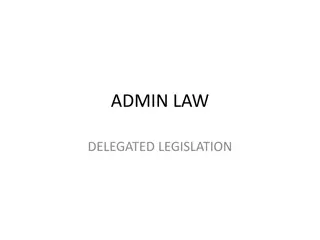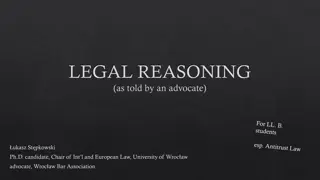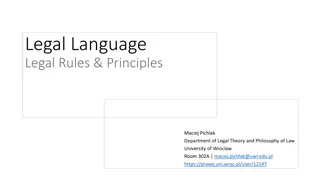
Legal System of the EU: Precedence Principle Explained
Learn about the fundamental principles of EU law, specifically the precedence of European law over national laws. Discover how the Court of Justice of the European Union enshrined this principle and its implications for Member States and citizens. Understand the absolute scope of the precedence principle and its application to all European acts with binding force.
Download Presentation

Please find below an Image/Link to download the presentation.
The content on the website is provided AS IS for your information and personal use only. It may not be sold, licensed, or shared on other websites without obtaining consent from the author. If you encounter any issues during the download, it is possible that the publisher has removed the file from their server.
You are allowed to download the files provided on this website for personal or commercial use, subject to the condition that they are used lawfully. All files are the property of their respective owners.
The content on the website is provided AS IS for your information and personal use only. It may not be sold, licensed, or shared on other websites without obtaining consent from the author.
E N D
Presentation Transcript
NATIONAL NATIONAL UNIVERSITY UNIVERSITY OF OF PUBLIC PUBLIC SERVICE SERVICE FACULTY OF INTERNATIONAL AND EUROPEAN STUDIES Legal System of the EU INITB133 Dr. Mikl s Szirbik, LL.M. 07.10.2019
Mikls Szirbik, Mikl s Szirbik, Legal System Legal System of of the the EU EU Which unwritten sources of INTERNATIONAL LAW do you remember?
Mikls Szirbik, Mikl s Szirbik, Mikl s Mikl s Szirbik Szirbik, Legal System of the EU , Legal System of the EU Fundamental Principles of EU Law Precedence of European law According to the precedence principle, European law is superior to the national laws of Member States. The precedence principle applies to all European acts with a binding force. Therefore, Member States may not apply a national rule which contradicts to European law. The precedence principle guarantees the superiority of European law over national laws. It is a fundamental principle of European law. As with the direct effect principle, it is not inscribed in the Treaties, but has been enshrined by the Court of Justice of the European Union (CJEU). - -
Mikls Szirbik, Mikl s Szirbik, Mikl s Mikl s Szirbik Szirbik, Legal System of the EU , Legal System of the EU The CJEU enshrined the precedence principle in the Costa versus Enel case of 15 July 1964. In this case, the Court declared that the laws issued by European institutions are to be integrated into the legal systems of Member States, who are obliged to comply with them. European law therefore has precedence over national laws. Therefore, if a national rule is contrary to a European provision, Member States authorities must apply the European provision. National law is neither rescinded nor repealed, but its binding force is suspended.
Mikls Szirbik, Mikl s Szirbik, Mikl s Mikl s Szirbik Szirbik, Legal System of the EU , Legal System of the EU The Court later clarified that the precedence of European law is to be applied to all national acts, whether they were adopted before or after the European act in question. With European law becoming superior to national law, the principle of precedence therefore ensures that citizens are uniformly protected by a European law assured across all EU territories.
Mikls Szirbik, Mikl s Szirbik, Mikl s Mikl s Szirbik Szirbik, Legal System of the EU , Legal System of the EU Scope of the principle The precedence of European law over national laws is absolute. Therefore, it applies to all European acts with a binding force, whether emanating from primary or secondary legislation. In addition, all national acts are subject to this principle, irrespective of their nature: acts, regulations, decisions, ordinances, circulars, etc), irrespective of whether they are issued by the executive or legislative powers of a Member State. The judiciary is also subject to the precedence principle. Member State case-law should also respect EU case-law.
Mikls Szirbik, Mikl s Szirbik, Mikl s Mikl s Szirbik Szirbik, Legal System of the EU , Legal System of the EU The Court of Justice has ruled that national constitutions should also be subject to the precedence principle. It is therefore a matter for national judges not to apply the provisions of a constitution which contradict European law. Example case: German Army, German Constitution, European Law
Mikls Szirbik, Mikl s Szirbik, Mikl s Mikl s Szirbik Szirbik, Legal System of the EU , Legal System of the EU Responsibility for ensuring compliance with the principle As for the direct effect principle, the Court of Justice is responsible for ensuring the precedence principle is adhered to. Its rulings impose penalties on Member States who infringe it, on the basis of the various remedies provided for by the founding Treaties, notably proceedings for failure to fulfil an obligation.
Mikls Szirbik, Mikl s Szirbik, Mikl s Mikl s Szirbik Szirbik, Legal System of the EU , Legal System of the EU Responsibility for ensuring compliance with the principle It is also the task of national judges to ensure the precedence principle is adhered to. Should there be any doubt regarding the implementation of this principle, judges may make use of the reference for a preliminary ruling procedure. In its judgment of 19 June 1990 (Factortame), the Court of Justice indicated that national courts, as part of a preliminary ruling on the validity of a national law, must immediately suspend the application of this law until such time as the Court of Justice gives its recommended solution and the national court gives its ruling on the substance of the issue.
Mikls Szirbik, Mikl s Szirbik, Mikl s Mikl s Szirbik Szirbik, Legal System of the EU , Legal System of the EU The direct effect of European law The principle of direct effect enables individuals to immediately invoke a European provision before a national or European court. This principle only relates to certain European acts. Furthermore, it is subject to several conditions. The direct effect of European law is, along with the afore mentioned principle of precedence, a fundamental principle of European law. It was enshrined by the Court of Justice of the European Union (CJEU). It enables individuals to immediately invoke European law before courts, independent of whether national law test exist.
Mikls Szirbik, Mikl s Szirbik, Mikl s Mikl s Szirbik Szirbik, Legal System of the EU , Legal System of the EU Definition of direct effect principle The direct effect principle therefore as a fundamental principle ensures the application and effectiveness of European law in EU countries. However, the CJEU defined several conditions in order for a European legal act to be immediately applicable. In addition, the direct effect may only relate to relations between an individual and an EU country or be extended to relations between individuals. The direct effect of European law has been enshrined by the Court of Justice in the judgement of Van Gend en Loos of 5 February 1963. In this judgement, the Court states that European law not only engenders obligations for EU countries, but also rights for individuals. Individuals may therefore take advantage of these rights and directly invoke European acts before national and European courts. However, it is not necessary for the EU country to adopt the European act concerned into its internal legal system.
Mikls Szirbik, Mikl s Szirbik, Mikl s Mikl s Szirbik Szirbik, Legal System of the EU , Legal System of the EU Horizontal and vertical direct effect There are two aspects to direct effect: a vertical aspect and a horizontal aspect. Vertical direct effect is of consequence in relations between individuals and the country. This means that individuals can invoke a European provision in relation to the country. Horizontal direct effect is consequential in relations between individuals. This means that an individual can invoke a European provision in relation to another individual. According to the type of act concerned, the Court of Justice has accepted either a full direct effect (i.e. a horizontal direct effect and a vertical direct effect) or a partial direct effect (confined to the vertical direct effect).
Mikls Szirbik, Mikl s Szirbik, Mikl s Mikl s Szirbik Szirbik, Legal System of the EU , Legal System of the EU Direct effect and primary legislation As far as primary legislation is concerned, i.e. the texts at the top of the European legal order, the Court of Justice established the principle of the direct effect in the Van Gend & Loos judgment. However, it laid down the condition that the obligations must be precise, clear and unconditional and that they do not call for additional measures, either national or European.
Mikls Szirbik, Mikl s Szirbik, Mikl s Mikl s Szirbik Szirbik, Legal System of the EU , Legal System of the EU In the Becker judgment (Judgment of 19 January 1982), the Court of Justice rejected the direct effect where the countries have a margin of discretion, however minimal, regarding the implementation of the provision in question (Judgment of 12 December 1990, Kaefer & Procacci).
Mikls Szirbik, Mikl s Szirbik, Mikl s Mikl s Szirbik Szirbik, Legal System of the EU , Legal System of the EU Direct effect and secondary legislation The principle of direct effect also relates to acts from secondary legislation, that is those adopted by institutions on the basis of the founding Treaties. However, the application of direct effect depends on the type of act.
Mikls Szirbik, Mikl s Szirbik, Mikl s Mikl s Szirbik Szirbik, Legal System of the EU , Legal System of the EU Regulation: regulations always have direct effect. In effect, Article 288 of the Treaty on the Functioning of the EU specifies that regulations are directly applicable in EU countries. The Court of Justice clarifies in the judgement of Politi of 14 December 1971 that this is a complete direct effect;
Mikls Szirbik, Mikl s Szirbik, Mikl s Mikl s Szirbik Szirbik, Legal System of the EU , Legal System of the EU Directive: is an act addressed to EU countries and must be transposed by them into their national laws. However, in certain cases the Court of Justice recognises the direct effect of directives in order to protect the rights of individuals. Therefore, the Court laid down in its case-law that a directive has direct effect when its provisions are unconditional and sufficiently clear and precise and when the EU country has not transposed the directive by the deadline (Judgement of 4 December 1974, Van Duyn). However, it can only have direct vertical effect; EU countries are obliged to implement directives but directives may not be cited by an EU country against an individual (Judgement of 5 April 1979, Ratti);
Mikls Szirbik, Mikl s Szirbik, Mikl s Mikl s Szirbik Szirbik, Legal System of the EU , Legal System of the EU Decision: decisions may have direct effect when they refer to an EU country as the addressee. The Court of Justice therefore recognises only a direct vertical effect (Judgement 10 November 1992, Hansa Fleisch); International agreements: in the Demirel Judgement of 30 September 1987, the Court of Justice recognised the direct effect of certain agreements in accordance with the same criteria identified in the Judgement Van Gend en Loos;
Mikls Szirbik, Mikl s Szirbik, Mikl s Mikl s Szirbik Szirbik, Legal System of the EU , Legal System of the EU Opinions and Recommendations: opinions and recommendations do not have legal binding force. Consequently, they are not provided with direct effect.
Thank you for your attention! Thank you for your attention!






















